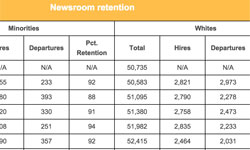The American Society of News Editors annual newsroom census, released this morning, found that job losses accelerated in 2014, falling by more than 10 percent in a single year.
The net job loss of 3,800 brings the total number of news professionals to 32,900 — with additional losses clearly taking place so far in 2015. That total is down just over 40 per cent from a pre-recession peak of 55,000 in 2006.
It’s the biggest single year drop since the industry was shedding more than 10,000 jobs in 2007 and 2008. The comparable figure for 2013 was 1,300 jobs and 2,600 in 2012.
The survey began in 1978 to track progress in improving diversity in newspapers’ newsrooms and leadership ranks and continues to embrace that mission. A limited bit of good news, noted by ASNE president Chris Peck in a press release, is that minority percentage of newsroom employment held close to steady, falling to 12.76 percent, compared to 13.34 percent the previous year.
While the report is labeled a census, it’s a survey — with the results from organizations reporting projected to a total industry figure for the nation’s roughly 1,400 daily papers.
This year, the response rate was down significantly to 43.8 percent compared to more than 70 percent the previous three years. Executive director Teri Hayt, said some members complained that it was difficult to complete the census because it asks for a count of employees in traditional categories like reporter and copy editor, making it unclear whether or how to count digital jobs like web producer.
The organization intends to retool the survey next year to better reflect the changing structure of newsroom and may also shoot for added measures of diversity progress than employment statistics.
Another challenge for the census is the shift of many desk and layout jobs out of individual newsrooms to corporate production hubs. Hayt said 10 such hubs were surveyed and all 10 responded, but she was less sure ASNE had identified all of them.
For several years ASNE has tried to include digital-only organizations in the survey. Clearly some of the gaps in newspaper editorial employment are being made up in that sector. But there has never been broad enough participation to project a total. The 47 organizations responding reported their newsrooms made up of 19.2 percent minorities.
ASNE’s commentary on the results says that papers in the circulation band of 250,000-500,000 bucked the general trend, recording an increase of nearly 14 percent in newsroom employment. But I’m mistrustful of the finding since the result can be influenced by changes in circulation numbers year-to-year and by which organizations decide to reply to the survey.
Even if not totally precise, the census is the best available indicator of trends in newsroom employment as the industry shrinks. Broadly the reductions have tracked revenue declines.
This year’s results at least suggest the possibility that newsrooms are taking a bigger share of expense control than in years past. But as I noted in an earlier post, the Newspaper Association of America has not yet produced an industry estimate for 2014 revenue declines, and with more than enough downbeat news about news out there, it’s not clear whether the organization will.
Related: Find out how diverse the American newspaper industry is with our interactive.








